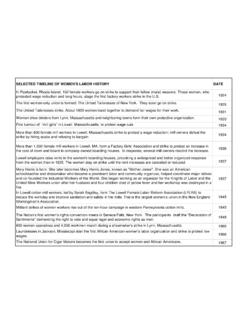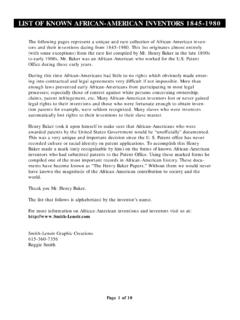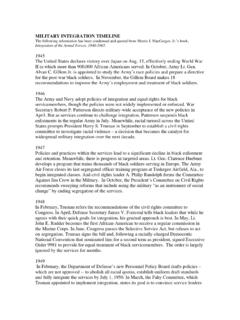Transcription of History of Street Gangs in the United States
1 Bureau of Justice Assistance Department of Justice National Gang Center Bulletin No. 4 May 2010. History OF Street Gangs IN THE United States . By: James C. Howell and John P. Moore Introduction The first active Gangs in Western civilization were reported characteristics of Gangs in their respective regions. by Pike (1873, pp. 276 277), a widely respected chronicler Therefore, an understanding of regional influences of British crime. He documented the existence of Gangs of should help illuminate key features of Gangs that operate highway robbers in England during the 17th century, and in these particular areas of the United States .
2 He speculates that similar Gangs might well have existed in our mother country much earlier, perhaps as early as Gang emergence in the Northeast and Midwest was the 14th or even the 12th century. But it does not appear fueled by immigration and poverty, first by two waves that these Gangs had the features of modern-day, serious of poor, largely white families from Europe. Seeking a Street More structured Gangs did not appear better life, the early immigrant groups mainly settled in until the early 1600s, when London was terrorized by a urban areas and formed communities to join each other series of organized Gangs calling themselves the Mims, in the economic struggle.
3 Unfortunately, they had few Hectors, Bugles, Dead Boys who found amusement in marketable skills. Difficulties in finding work and a place breaking windows, [and] demolishing taverns, [and they] to live and adjusting to urban life were equally common also fought pitched battles among themselves dressed among the European immigrants. Anglo native-born with colored ribbons to distinguish the different factions Americans discriminated against these immigrants as (Pearson, 1983, p. 188). well. Conflict was therefore imminent, and Gangs grew in such environments.
4 The History of Street Gangs in the United States begins with their emergence on the East Coast around 1783, First came the old immigrants, those who came to as the american Revolution ended (Sante, 1991). But the United States from Northern or Western Europe there is considerable justification for questioning the (especially Great Britain, Germany, and Scandinavia). seriousness of these early Gangs . The best available during the first wave of immigration following american evidence suggests that the more serious Street independence and extending up to about 1860.
5 The Gangs likely did not emerge until the early part of the second enormous group of immigrants the Poles, nineteenth century (Sante, 1991). Italians, Irish, and Jews overlapped the first wave, arriving during the 1820 1920 period. Both groups largely consisted of low-skilled, low-wage laborers. The Influence of Population Not unexpectedly, the second wave on top of the first one overwhelmed the housing and welfare capacity of Migration Patterns on Gang the young Northeast and Midwest cities,2 contributing Emergence directly to slum conditions and the accompanying crime problems, Gangs included (Riis, 1902/1969).
6 The slum is This bulletin examines the emergence of gang activity as old as civilization. Civilization implies a race [among in four major regions of the United States : the Northeast, social strata] to get ahead They drag one another Midwest, West, and South. ( Gangs would emerge in the farther down. The bad environment becomes the South much later than in other regions.) The purpose of heredity of the next generation. Then, given the crowd, this regional focus is to develop a better understanding you have a slum ready-made (Riis, 1902/1969, p. 1). of the origins of gang activity and to examine regional migration and cultural influences on Gangs themselves.
7 In contrast, Gangs grew out of the preexisting Mexican There is some evidence that the Gangs that first emerged culture in the Western region, and their growth was in each of these regions influenced the growth and fueled by subsequent Mexican migrations. El Paso, Albuquerque, and Los Angeles initially were populated 1 Serious Street Gangs are typically characterized as having a by immigrant groups along the trail from Mexico to multiple-year History , having a large membership (varies widely), Los Angeles. The continuing influx of Mexicans fueled being somewhat organized (having some sort of hierarchy and leadership roles), and being involved in violent crimes in the course of Street presence ( , homicide, aggravated assault, robbery, use 2 The Bureau of the Census designates four major regions of firearms) (Howell, 1999, 2006).
8 (Midwest, Northeast, South, and West). 1. gang growth. Indeed, they brought an embryo, or pre- rapid immigration and ensuing political, economic, and gang, culture with them that was transmitted by youth social disorganization. who had been named pachuchos, after field hands from a Mexican city of that name (Geis, 1965). These pachuchos socialized with other immigrant youths in First Period of Gang Emergence the streets (Vigil, 2002). in New York City The Nor theast, Midwest, and Western regions The members of the Gangs that first drove social stakes would soon be inundated with a second major wave in the streets of New York in the late 18th century were of immigrants, african - american populations that the same age as most members of current Street Gangs , migrated northward and westward from the Deep from the early teens to about the mid-twenties (Sante, South.)
9 In addition, other gang mixtures including 1991). They consisted of five main groups: The Smiths's Hispanic/Latino3 (Puerto Rico, Mexico, Dominican Vly gang, the Bowery Boys, and the Broadway Boys Republic, Cuba), Asian (Cambodians, Chinese, Filipinos, were white, mainly Irish groups; the Fly Boys and the Koreans, Samoans, Thais, Vietnamese, and others), and Long Bridge Boys were black (p. 198). There already Latin american (Colombians, Cubans, Dominicans, was a substantial black population in the area (Sante, Ecuadorians, Panamanians, Puetro Ricans, and others) 1991, p.
10 199). would later populate the gang landscape (Miller, 2001, p. 43). Native- american Gangs also would emerge, but It is important to examine more closely the racial/ethnic much later (Conway, 1998). The internal migration of the character of the early New York Gangs described here. blacks mainly fueled the emergence of another distinct Overall, the earliest Gangs were largely Irish, followed wave of gang activity. The end result was a mixture of after the Civil War by Italian and then Jewish Gangs predominantly white, Mexican, and black Gangs with with a mixture of Italian, Irish, and Scandavian members varying degrees of influence in each of the three early (Riis, 1902/1969; Sante, 1991).














